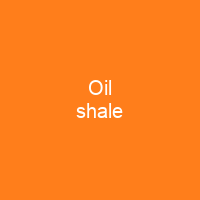Oil shale is an organic-rich fine-grained sedimentary rock. Deposits of oil shale occur around the world, including major deposits in the United States. Heating oil shale to a sufficiently high temperature causes the chemical process of pyrolysis to yield a vapor. Oil shale can also be burned directly in furnaces as a low-grade fuel for power generation and district heating.
About Oil shale in brief

While the bitumen portion of oilShale is soluble in carbon disulfide, kerogen portion is insoluble in carbonDisulfide and may contain iron, vanadium, nickel, molybdenum, and uranium. Some deposits contain significant fossils; Germany’s Messel Pit has the status of a Unesco World Heritage Site. Inorganic matrix can contain quartz clays, pldspars, carbonates, silicates and some minerals. Geologists can classify oil shale on the basis of their composition as carbonate-rich shales or siliceous shales. This classification is based on the initial designs petrographic terms from coal, lacustrine or marine environment. The most commonly used classification of oilshales is van Kreen diagram, which assigns oil kerogen types, depending on the hydrogen, carbon, oxygen, and oil content of the original organic matter. The total world resources of oil Shales equivalent of 6. 05 trillion barrels of oil in place is estimated to be 6.05 trillion barrels, according to a 2016 estimate of global deposits set the total world reserves of oil. OilShale gains attention as a potential abundant source of oil whenever the price of crude oil rises. It does not have a definite geological definition nor a specific chemical formula, and its seams do not always have discrete boundaries. It differs from oil-bearing shales, shale deposits that contain petroleum that is sometimes produced from drilled wells.
You want to know more about Oil shale?
This page is based on the article Oil shale published in Wikipedia (as of Dec. 03, 2020) and was automatically summarized using artificial intelligence.







